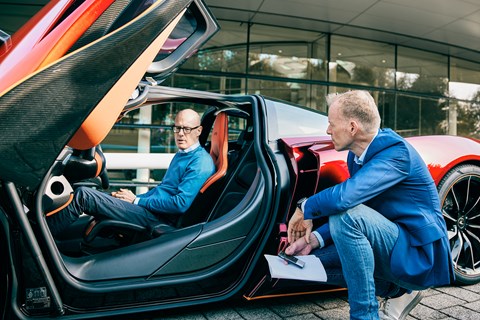► CAR’s exclusive interview with Michael Letters
► Former Ferrari tech chief takes over Woking
► How will he take McLaren to the next level?
This content was part of CAR magazine’s 60th anniversary celebrations, split over three editions. Want to read more from those editions, as well as get access to more amazing content from CAR? Become a member here with a 99p trial!
To understand how far McLaren Automotive has come in 12 years, listen to the words of a former Ferrari chief technical officer.
‘I always had a high opinion about McLaren,’ he says. ‘As an automotive brand, it’s very young. But it’s achieved a very high level of brand and product. You can feel the purism and the performance of a racecar maker if you drive a McLaren road car. And a lot more.’
That ex-Ferrari CTO is Michael Leiters. And he’s now the CEO of McLaren Automotive.
We’re sitting at the conference table in Leiters’ office, overhanging the main entrance to the McLaren Technology Centre in Woking. An office that stood empty for nine months after his predecessor, Mike Flewitt, stepped down in October 2021.

Leiters’ CV suggests he’s the perfect recruit. He rose to prominence as a key engineer on Porsche SUVs. Ferrari launched its first electrified series cars on his watch. It’s no exaggeration to say McLaren’s future hinges on both those technologies.
Softly spoken and hugely thoughtful, Leiters loves talking automotive engineering. At Ferrari, he made sure he had sufficient seat-time in McLarens, which his team studied in detail. ‘McLarens were very relevant and in some areas benchmark: light weight, steering feel, brake-pedal feeling. Things that are really important for vehicle dynamics are done very, very well.’
McLarens are special to drive: CAR has crowned a McLaren our Sports Car of the Year four times in the past decade, once more than both Ferrari and Porsche. Core to those victories have been an agility bred from light weight and steering that feels more drilled into the road than cats’ eyes. Leiters vows to nurture both.
While both Porsche and Ferrari have deployed solely electric power steering assistance on recent cars, McLaren retains hydraulic assistance (though with an electric-powered pump). ‘We won’t go to electric-mechanical steering before we’re sure that we can have the same steering feel as today,’ asserts the CEO. ‘Those with an e-motor supporting the mechanical steering risk losing a little bit of the feeling of the road surface.’
This is fundamental to Leiters’ belief that ‘every moment a customer has with their car has to be emotional’. From a first glance at the exterior design, to the sensations triggered by dropping into the driving seat, to the feedback at 2000 revs in the city centre. At the other end of the spectrum, it’s about developing systems like Variable Drift Control, allowing drivers to enjoy the buzz of oversteer safely.

Does the Artura, the all-new McLaren hybrid Leiters inherited (and late-running due to software bugs), deliver sufficient emotion? ‘I was positively surprised. The Artura is really light and nimble, with very good feeling in the steering and paddles. Driving one every day I appreciate the usability, with good ride comfort and driver visibility.’
The Artura’s drivetrain is V6 hybrid, just like the Ferrari 296 GTB’s. The McLaren is 75kg less than the Ferrari’s 1470kg dry weight. That’s partly determined by McLaren’s carbonfibre monocoque tubs, built at the McLaren Composites Technical Centre in Sheffield.
I ask about the MCTC and the 51-year-old CEO shoots back: ‘Have you been there? A world-class centre of technology. Carbonfibre is super consistent with our brand and product DNA. It gives us a competitive advantage on light weight and performance.
‘And doing it in-house brings us a cost advantage. And nobody has a technology which allows them to have this performance, with this cost. Nobody, nobody,’ he stresses.
McLaren introduced F1’s first carbonfibre racer in 1981, and now all its road cars are made of it. But it’s also restricted McLaren to two-seat mid-engined supercars: will there be more flexibility in future?
‘Exactly. I think we can create a lot of flexibility to vary actual products or create new ones. We will develop our technology and product road map and understand what investment is necessary.’
Leiters then critiques a line-up lacking ‘differentiation’. Until the Artura, all cars have used a twin-turbo V8 and a numeric naming system tagged to a model’s power output, which is confusing because different series overlap. ‘And our cars’ design isn’t differentiated enough. We need a clear brand design language and design elements which define each product, like a 720S versus an Artura.’
Will their common carbonfibre structure give McLaren an advantage as electrified cars increasingly add weight? ‘Two core elements of McLaren will help us in more hybridisation or electrification: weight and aerodynamics. We are very well prepared in these areas. But we have to invest and go further in electrification.’

This triggers a long conversation about electrified McLarens. Leiters’ predecessor talked of a pure electric Ultimate Series prototype to explore hypercar range and circuit capabilities. ‘I haven’t seen any prototypes but I have seen good ideas and good studies, of how we could set up a modular platform for electric sports cars.
‘But for today’s McLaren supercars, the technology is not mature. It will take another step in battery technology [to solid state]. A battery supplier once told me “Every year we postpone it for two years!” It will take many years until you can drive one at the Nürburgring.
‘I could do it with lithium-ion batteries but it’s not a convincing product: weight is too high. Longitudinal acceleration is no problem for EVs. But you must have low weight to get the right dynamics.’
Leiters is focused on how to compensate for the emotional loss of a high-performance engine, and managing any EV’s ‘digital’ power and torque delivery to ensure it feels natural. So will there be an electric McLaren EV this decade? ‘Yeah, it’s possible,’ he concedes.
Just don’t bank on it being a supercar. Do the brand’s customers want a McLaren to fit their families?
‘Yes. I think this is an effect almost every great brand has: a customer falls in love with your product. Why shouldn’t you offer something for a totally different purpose without negating your brand DNA? There are very, very good market examples demonstrating this.’
This advocate of the Porsche Cayenne and Ferrari Purosangue admits McLaren will be stronger for embracing ‘new car concepts’; the former regime was so ideologically opposed to SUVs, it showed pictures of rivals’ cars crossed out in investor presentations.
A McLaren crossover is sure to use composites – ‘it has to be lightweight, and carbonfibre is one of the best ways to do this’ – and be pure electric. The company isn’t ruling out working with other car makers; CAR has reported on nascent discussions with BMW.
But first McLaren must be turned around. The group took action to shore up its position during Covid: separating loss-making McLaren Racing to stop its drain on Automotive, selling and leasing back the McLaren Technical Centre and drawing in £550m of funding.
‘I’m totally convinced this company can be profitable,’ states Leiters with calm certainty. ‘It can be profitable with a streamlined version of today’s line-up. I think it can be even more profitable if we think about the new segments. But the main turnaround issue is to get self-sufficient, so we can sustain the business with our earnings.’

And have the shareholders asked him to deliver a specific annual volume? ‘No!’ the boss retorts. ‘And they won’t do. We want to have the right size to be profitable, and to have profitable dealers.
‘One of the biggest mistakes this company did was in 2018-’19, oversupplying the market and destroying residual values. It wouldn’t be a problem to have 3-, 5-, 10,000 cars a year – if you have the right portfolio and the right demand.’
Leiters is also supremely focused on tackling McLaren’s Achilles’ heel: quality and reliability. ‘It was a tough decision to delay the Artura to solve our quality problems,’ he admits. ‘This brought the company financially to the edge but we did it to protect our brand. This shows the focus we will have on quality in the future.’
The new CEO is revising the organisation, to ramp up quality and iron out problems in the development phase. ‘We stretched a little bit the approach of being a start-up. We pushed a lot, but didn’t take the tough decision to leave a little [time] before delivering. It’s not right to have the customers as a tester of our cars.’
On the day we meet, Michael Leiters is 76 days into his tenure. Another German engineer, Tobias Moers, didn’t last long in his attempt to revive Aston Martin. Leiters will be less confrontational. He vows to bring ‘technical and emotional leadership’, to encourage his employees to unite to solve problems and find the ideas to take McLaren to the next level. ‘I would like to leave a company which is at the top of supercar manufacturers and can react to all changes, from the market, from regulators, from new technologies. I want McLaren to be sustainable – and to continue to be successful.’